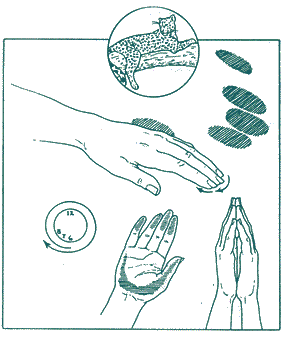How to Do the TTouch®
 The foundation of the TTouch® is based on circular movements of the fingers and hands all over the body. The intent of the TTouch® is to activate the function of the cells and awaken cellular intelligence - a little like "turning on the electric lights of the body." The TTouch® is done on the entire body, and each circular TTouch® is complete within itself. Therefore it is not necessary to understand anatomy to be successful in speeding up the healing of injuries or ailments, or changing undesirable habits or behavior.
The foundation of the TTouch® is based on circular movements of the fingers and hands all over the body. The intent of the TTouch® is to activate the function of the cells and awaken cellular intelligence - a little like "turning on the electric lights of the body." The TTouch® is done on the entire body, and each circular TTouch® is complete within itself. Therefore it is not necessary to understand anatomy to be successful in speeding up the healing of injuries or ailments, or changing undesirable habits or behavior.
To do the TTouch® , imagine the face of a clock on your animal's body, half an inch to one inch in diameter. Place your lightly curved fingers at six o'clock on your imaginary clock, and push the skin around the face of the clock for one and a quarter circles. Place your thumb two to three inches from your forefinger and feel a connection between thumb and forefingers. When possible, support the body gently with your free hand, placing it opposite the hand making the circle. Maintain a steady rhythm and constant pressure around the circle and a quarter, whether the TTouch® is light or firm, pay particular attention to the roundness of the circles.
After each circular TTouch® you can either move to another spot at random, or you can run parallel lines on the body by making a circle with a little slide and then another circle. Both types of movements induce relaxation and improve self-confidence. By placing your free hand in a supporting position and making a connection between your two hands, this will keep the animal in balance and enhance the effect of the TTouch® .
Most of the time, clockwise circles are the most effective for strengthening and rehabilitating the body, as well as improving self-confidence and performance. However, there are times when counterclockwise circles are appropriate for releasing tension. Practice the both directions and trust your fingers if they are moving in a counterclockwise direction.
Pressure
The TTouch® pressures range on a scale from one to ten. To get a sense of these pressures, support your bent elbow with one hand, and with the other, rest your thumb on your cheek and use your fingers to gently move the delicate skin below your eye in one-and-a-quarter circles. Be careful not to slide your finger across the skin. Repeat the same circle on your arm and notice that there is almost no indentation in your skin with a Number 1 pressure.
To feel the Number 3 pressure, move your fingers, approximately an inch down, to your cheekbone. Allow the weight of your curved middle find pad to connect clearly with your cheekbone and make another circle. Repeat this same pressure in a circle on your arm and observe the indentation in your skin. Notice the difference between Number 1 and 3 pressures. The Number 2 pressure is between 1 and 3.
To discover a "six pressure" press twice as deep. We rarely use more than a "six pressure" on dogs and cats. On horses (and humans), we occasionally go as high as nine. Instead of pressing three times deeper than the "three pressure," we tip the first joints of the fingers so that the fingernails are pointing directly into the muscle and apply three times the pressure. (See the Bear and Tiger TTouch® cards.) This TTouch® is more comfortable for the person doing the touch, and the animal or human gets a much deeper connection than simply applying pressure.
Experiment with the pressure until you click into the one that is "right" for the animal you are working on. Small creatures call only for the lightest pressures. Larger or heavily muscled animals may be more responsive to the deeper pressures, but not always. If there is pain or inflammation in the body, you may have to begin the touch with a two or three pressure, and then establish the right level at which to work.
As you become familiar with the various TTouches, you will intuitively know which to use. If your animal friend is not comfortable with one TTouch® , choose another. With practice, you will find both you and your animal will benefit from this experience.



